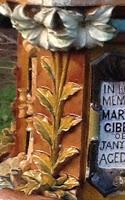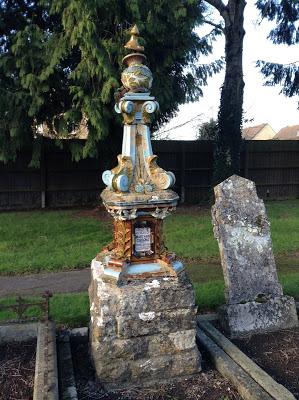
I was in Chesterton Cemetery in Cirencester, Gloucestershire, looking for an entirely different grave (which I'll tell you about next week) when I came across that wonderful grave shining in the wintery sunshine. I took some photographs, looking not only at the whole 'marker' but also a mysterious plaque that read 'JG'. I wanted to know more and after I posted them on my Facebook page, I wasn't the only one. So I had a bit of a metaphoric dig...
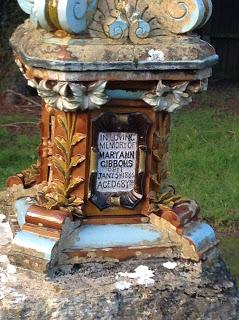
The grave is dedicated to Mary Ann Gibbons, who shuffled off this mortal coil on 5th January 1886 aged 68, so she was born in 1818. There is a little extra 'tomb' on top of the plot which has this ceramic plaque on the side...
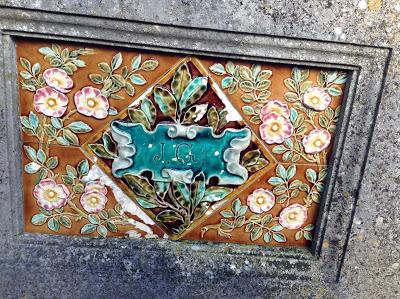
Unleash the historian! Well, have a bit of tea first and a walnut whip, then unleash the historian!
So, armed with that small amount of information, two hours ago I leapt into action. Turns out that Mary Ann Gibbons and I were bound to meet eventually as she had a bit of a secret hidden behind Victorian majolica lilies, but I'll come to that. First of all, why was it all so ornate?
Mary Ann Lewis was born in 1818 to Samuel and Mary Lewis, in Lydiard Millicent, Wiltshire, not far from her eventual home in South Gloucestershire. She married James Gibbons (the 'JG' from the grave) in the early 1840s and they had 8 children between 1844 and 1860. James was from Kemble, a small village not far from Cirencester and home now to an airfield and a railway station, but not a great deal more. James was in the building trade, as was his father before him and by 1881, he was listed as a master plasterer, employing one person. It is unsurprising therefore that his sons would follow in the family tradition, but it is amazing how influential they would be.
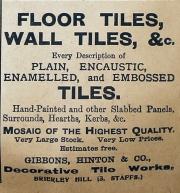
1908 advert
By the look of those wonderful lilies, there was some amazing craft involved in the grave. Mary Ann's sons, Owen (1847-1911), Francis (1853-1918) and Arthur (1858-1917) were the artistic members of the family, moving the Brierley Hill in Staffordshire to create the most amazing art and tiles, often combining the two...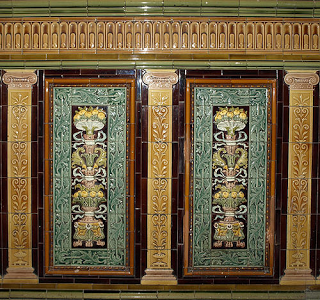
Tiles by Francis at the Brierley Hill Technical Institution
I owe a debt of thanks to The Brierley Hill blog for making my life easier this evening, and I won't paraphrase their wonderful work, but direct you to here for more information on the children and their work. The 'Hinton' in the company name is described as a brother-in-law to the Gibbons boys, so is probably a relative of Sarah Gibbons' (1850-1890) husband, William. Anyway, a quick wallow in the beauty of their work, then back to the parents...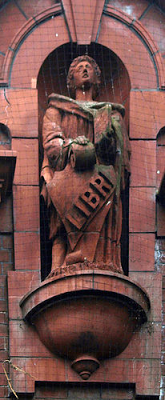
Arthur Gibbon's statue above the door to the library
at the Technical Institute
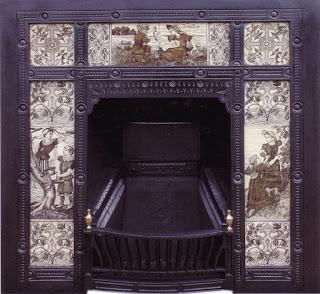
Owen Gibbons' fireplace

Decorative 'pheasant' tiles from Gibbons, Hinton & Co
Right, back to James and Mary Ann. Only one of their children pre-deceased them, Albert (1845-1868), the rest of them living fulfilling is not all very long lives. Mary Ann and James remained in Cirencester where Mary Ann became ill. As it's me telling this story, obviously I don't mean physically ill...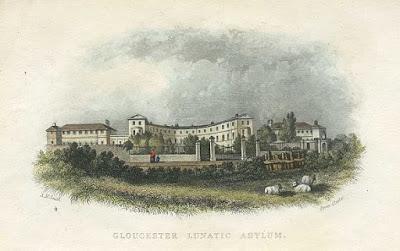
Well, of course it's an asylum
Mary Ann was admitted to the Gloucestershire County Asylum in the summer of 1881. Interestingly, she came to Horton Road Hospital (as it was also known) just as it was full to bursting with patients and a second asylum was opened just two years later at Coney Hill. This second hospital was a more rural, peaceful affair, specialising in private patients. Poor Mary Ann lived out the rest of her days in the great curved building above, dying there in 1886. James lived on in Cirencester, but he too died in 1891.